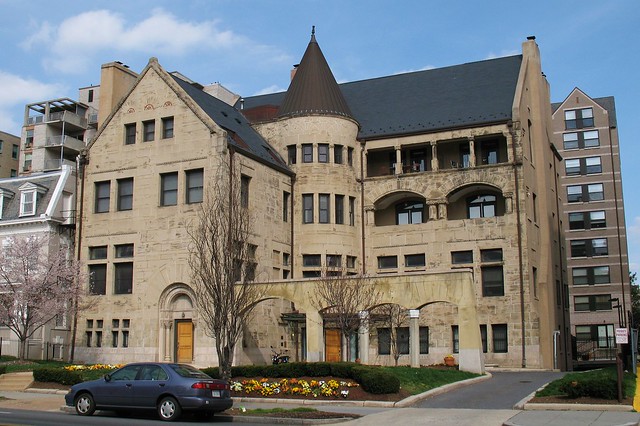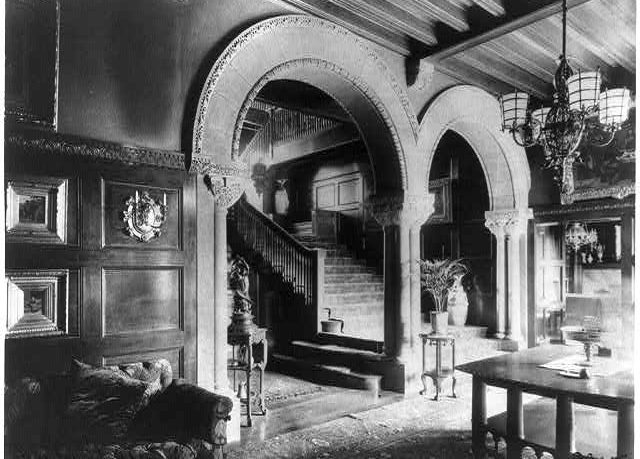 |
| Warder-Totten Mansion, Mr. T in DC |
You may have noticed this building, the Warder Mansion, on 16th Street between Euclid and Fuller. It’s a pretty nice looking building that stands out from the surroundings, and it turns out it was designed by HH Richardson, one of the most famous architects of the 19th century. But aside from being an interesting building from a famous architect, it’s got a great story.
DCist originally alerted me to the tale: the mansion was built in the 1880s, but at 15th and K Streets downtown. It was the home of Benjamin H. Warder, who was a partner in Warder, Bushnell and Glessner, a big agricultural equipment company that eventually became International Harvester after something called the “Harvester Wars” — I guess the 19th century version of the Cola Wars.
Richardson was a prominent architect at the time: he designed Trinity Church in Boston plus many courthouses and academic buildings, and even spurred an architectural style: Richardsonian Romaneqsue. Glessner of Warder’s company had his house built by Richardson in Chicago and two of the three other houses Richardson designed in DC were the homes of John Hay, Lincoln’s private secretary and later Secretary of State, and author and historian Henry Adams. Both houses were later demolished by real estate developer Harry Wardman (who also built Clifton Terrace/Wardman Court among other things) and replaced with what is today the Hay-Adams Hotel.
Back to the mansion at 15th and K, where the Warders seemed to be doing well for themselves. The inside was quite opulent (check out some of the photos) and Benjamin had been doing some building himself, including the Warder Building at 9th and F downtown, which was later incorporated into the Spy Museum. There was (and maybe still is) a Warder Apartment building somewhere else in town, but I can’t find much more about it.
 |
| Warder Mansion interior, 1900, from Libary of Congress |
When Warder’s business partner Glessner died, he donated his house to the American Institute of Architects. The Warder Mansion, however, did not have quite such a nice fate. A City Paper article from 2001 has more: Benjamin died in 1894 in Egypt and his widow lived in the mansion until 1921. The rest of his family had already moved out and developers wanted to build an office building in its location, prime real estate on K Street — and they did, the Investment Building.
But before the Warder House was torn down to make way, architect Charles Oakley Totten Jr., who designed a number of the embassies on 16th Street near the mansion’s present location, decided to save it. In about 1923 he moved the house, stone by stone, up 16th Street in his Model T Ford. He rebuilt it in its present location, which was at the time the formal garden of his residence. (There was an article in the 1921 American Architect magazine about that residence, before the mansion was moved, which is available online. That building, which looked like a French farmhouse, was later torn down and a big apartment building was constructed facing 15th Street.)
But that’s not the end of the story. Totten died in 1939 and left his widow without any money, and soon the family lost the house. Various tenants then inhabited it, including a clinic, the National Lutheran Council, and Antioch College of Law, which closed in 1986 and was absorbed into what became UDC’s David A. Clarke School of Law. After the law school left, however, the building fell into disrepair, like many other abandoned buildings in the neighborhood.
It was empty from 1986 to 2001 while owner Ali Qaragholi was accused of demolition by neglect by neighborhood residents, historic preservationists, and Totten’s son, who alleged that Qaragholi wanted to build an apartment building in its location. Homeless people and drug dealers used it and it was subject to at least five suspicious fires despite the fact that it was put on the National Register of Historic Places in 1972. The city’s Department of Consumer and Regulatory Affairs was also faulted for not enforcing building codes and historic preservation laws.
Then finally in 2001 it was sold to American Housing Partnership, which converted the Warder Mansion into luxury apartments and built the apartment building behind it on 15th Street, where Totten’s French farmhouse used to stand. I spoke with someone who lived in the Warder Mansion a few years ago, who said the apartments, about 4 or 5 on each floor, were renovated to a modern style with hardwood floors and granite countertops. I guess there was no trace of the original fancy fixtures after the move, fires, and occupation by drug dealers.
Apparently there have been a few issues with the place as apartments, but at least the residents didn’t have to move the building stone by stone. An interesting little slice of neighborhood, and DC, history.




